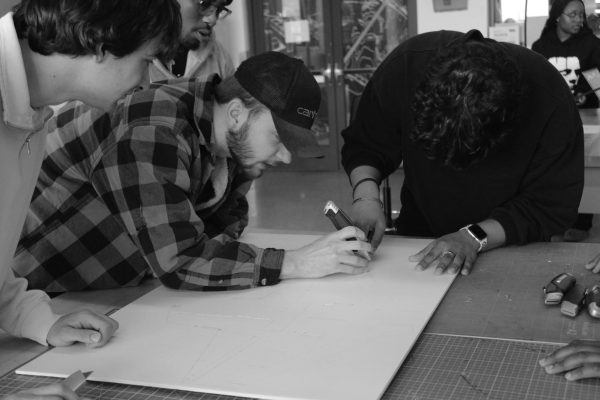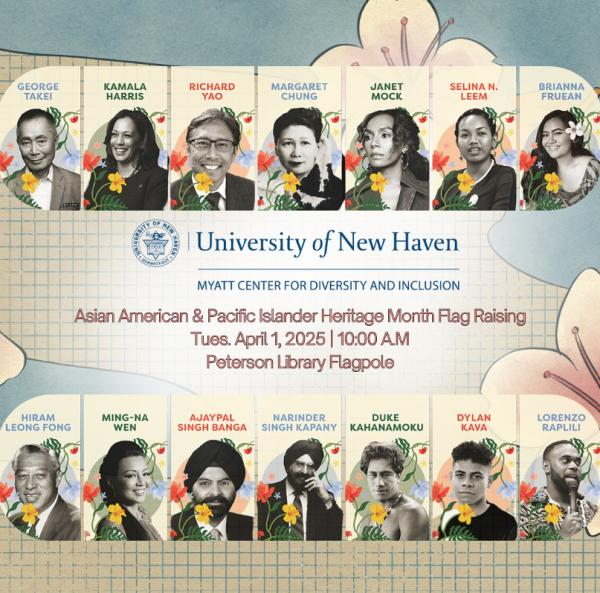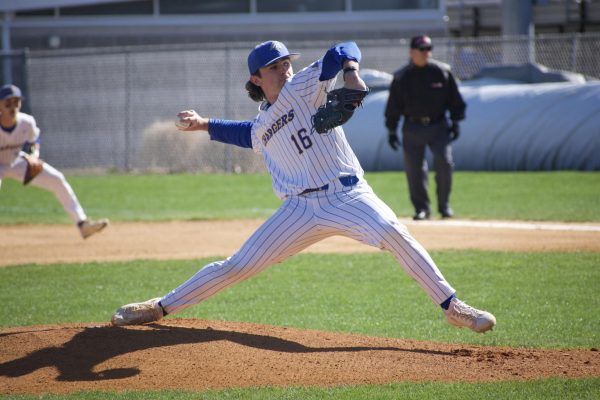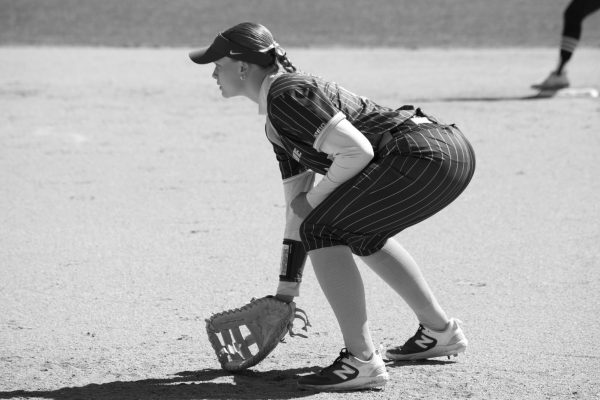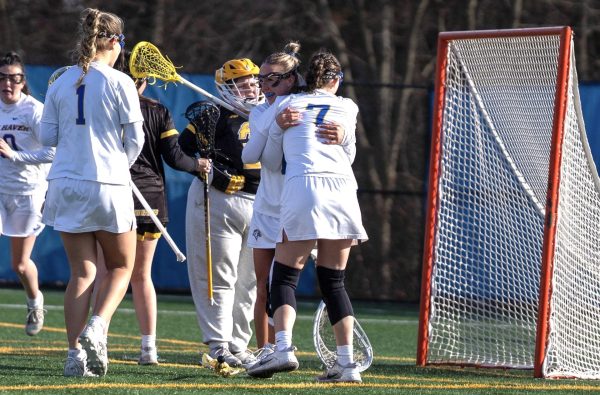Holocaust Remembrance Ceremony brings campus community together against hate
As live, somber music filled the room, guests filed into Bucknall Theater on a breezy April afternoon and were greeted with a program detailing the ceremony. The back cover of the pamphlet read the chilling words, “These victims of the Holocaust were friends and family members of people in the [University of New Haven] community.” Just below, at least 107 names and an unknown number of family members left unaccounted for lined the cardstock.
The university held its 19th annual Holocaust Remembrance Ceremony last Wednesday to honor and remember those we lost to one of the most diabolical acts against humanity that our world has ever seen.
After a presentation of the nation’s colors by the university’s ROTC color guard, Interim Provost and Vice President for Academic Affairs Nancy Savage provided context of the history and magnitude of the Holocaust. She defined the purpose of the afternoon’s ceremony as “to solemnly honor, with utmost dignity, the memory of those who were slaughtered,” and “to instill in our students the clearest possible lessons on the importance of ethical behavior, particularly in the context of respect for human life and dignity in all of its manifest diversity.”
Savage also noted some of the ways in which the university upholds these values of respect and education. These include the establishment of the Myatt Center for Diversity and Inclusion, the creation of multiple courses within the College of Arts and Sciences dedicated to this tragedy, the Poland study-abroad program, as well as the Oskar Schindler Humanities Endowment Professorship which honors faculty members who display the highest levels of humanitarianism and empathy.
Savage concluded her piece with the acknowledgment of two harrowing dates. She first recognized the day which the remembrance fell on as the 80th anniversary of the Warsaw ghetto uprising, the largest Jewish mass revolt of World War II. She then commemorated the events of Oradour-sur-Glane – a French village of mostly non-combatants who were annihilated by Nazi infantry without reason – and the life of its last survivor, Robert Hébras, who passed away on Feb. 11 of this year.
Ira Kleinfeld, chair of the Holocaust Remembrance Day planning committee and emeritus professor of industrial engineering, acted as the master of ceremonies for the afternoon. He led a group of eight students in lighting eight candles: six for each of the six million Jews who were killed during the Holocaust; one for the million people who were ostracized and killed for other identities such as religion, sexual orientation or disability status; and one for the million other people who defied the Nazi regime and offered their assistance to a cause they deemed larger than themselves at the cost of their own safety.
Introduced next was Judy Birke, who was merely a child during the Holocaust. She read her poem “I am a Survivor,” which speaks about the tragic juxtaposition of not remembering the events of the massacre yet carrying with you the bloody inheritance and poisoned lineage of a family taken from you by an entity of hate and disdain for life. Coming to terms with the events of her past could not have been easy, but her words seemed to imply a life well-lived which has granted her a sense of catharsis.
“Realization has been difficult,” Birke said. “Acceptance has taken time. Discovery and release; it gives me calm, it gives me peace. It allows me to stop running, it allows me to catch up with myself. It enables me to embrace my being with grace and gratitude and understanding. I am sad. I am happy. I am no longer silent.”
Birke’s poem closed by repeating a mantra of “I continue to,” followed by a remnant of her endurance, these inculcations serving as a present manifestation of her survival. She ends by saying, “I continue to hang on, sometimes I succeed.”
Kleinfeld then introduced the keynote speaker of the ceremony, Daphne Geismar. Her book, “Invisible Years,” recounts “the story of nine family members, her parents, grandparents, aunts and uncles, in their own words alongside a trove of photographs and other artifacts.” As the lights dimmed, Geismar began.
The primary documents which guide the book’s narrative were shown to Geismar by her mother after she learned of her grandparents’ hiding place in a church in Rotterdam, the Netherlands during its Nazi occupation. In the bottom drawer of an antique desk lay over 50 documents and primary sources, and the lining paper at the bottom of this drawer was transformed into the endpapers for “Invisible Years.”
Geismar is not the primary storyteller in her book; rather she relinquishes her voice to her ancestors, allowing each of them to be their own author and narrator as they describe the brutality, isolation and uncertainty of the Holocaust to the reader and across generations to each other. For the first half of the book, these stories and voices are interwoven and told in chronology.
Accompanied by her husband and a friend in order to distinguish between the various voices present in the book, Geismar proceeded to read a few excerpts for the audience. One aspect which shines through early in the retelling is how people of different ages reacted at the outset of the Holocaust. Geismar’s grandparents were rightfully worried about their family’s future: the star that Jews were mandated to wear on their clothes targeted them for relocation and marked them for death. Her mother and aunt, however, who were not yet teens at this point, retained their kindred cynicism.
“Chaim and Fifi made arrangements for the girls to go to an improvised school with Jewish teachers,” Geismar said. “Mirjam’s opinion about this? ‘We were about to be murdered by the Nazis and our parents were still worried about our education.’”
Stripping anyone of their rights as humans is an irredeemable offense. But the most heart wrenching detail of Geismar’s familial story and the Holocaust is the persecution of children. Throughout the book and her keynote speech, she showcases a plethora of family photos. Seeing children in these pictures – especially when they were so young – and having even the slightest idea of the hell which they had to go through makes your stomach turn. The most that a child should have to worry about is what has been packed for their school lunch, when that loose tooth is going to fall out, and maybe a scraped knee on a bad day. Anything but this.
For most of the second half of “Invisible Years,” the stories retreat into their own chapters to discuss the family’s individual instances in hiding which allows each to be internalized uninterrupted. Across Geismar’s eight family members, there totaled 27 different hiding locations, each carrying its own unique circumstances.
“Some could never leave their hiding places, others hid in plain sight,” Geismar said. “There were Nazi raids on two hiding places; my maternal grandparents were not discovered, my paternal grandfather was. Most protectors were remarkable humanitarians. One was a Nazi sympathizer. And the father and two sons of one family were abusive.”
To live in separate hiding locations means that children were forced to search for shelter alone. Unfortunately, Geismar’s aunt Judith alone was the one subject to the abusive family.
“The last family I was hiding with was where it happened,” she recited. “The father and two of his sons, 16 and 17 years old, abused me. There was nothing I could do and nobody I could go to. I never told my parents.”
Toward the end of the book, Geismar’s family reunite and the interwoven storytelling of the first half returns. Although together once again, time and circumstance have done irreparable damage to their dynamic and they must put the pieces back together from memory. One of those pieces, Geismar’s grandfather Erwin, does not return.
A catastrophic event such as the Holocaust, although not nearly rare enough, is very rare in human history. Millions of people died and innumerable more were forced to live with the fact that they could have been a tally mark in that statistic. No one is expected to be able to cope with the effects of that grief, sorrow and guilt, even if most of their family unit remains intact and they do not experience the brunt of tragedy. Chaim attempted to make sense of these overwhelmingly confusing emotions in a letter to Mirjam and Judith.
“When we were free once again, it was as if life itself had been put back into our hands,” Geismar recited. “Our very life had been stripped from us. Gladness and gratitude overwhelmed me, gratitude to all who supported us during the war years. And an emotion of thankfulness which I will call divine. But this feeling was almost immediately stifled, remembering just one of the millions of children who would not return.”
As she drew to the end of her keynote speech, Geismar reminded the audience to remain disciplined in their opposition to discrimination and hate. Germany did not adopt Naziism overnight, nor did Naziism ever remain stagnant in its strategy. A society dedicated to the preservation of humanity must be always evolving to ward off those who try to tear others down. With her parting words, Geismar said, “The witnesses in my family are my teachers and my inspiration. May they be yours, too.” Copies of her book were available for purchase after the ceremony, as well as a book signing.
Kleinfeld returned to the stage and reinforced the bravery and selflessness exhibited by those who chose to help the persecuted by hiding them in their homes. He called upon the words of a former Holocaust Remembrance Ceremony keynote speaker, Sam Gejdenson, whose parents survived the Holocaust. When referencing the kind souls who sheltered Gejdenson’s family, Kleinfeld said, “The choices facing such a potential helper were so awesome in consequence that he could not honestly say that if he were in the same circumstances, that he’d be able to make the heroic decision that that Polish farmer did.”
Kleinfeld then reflected on the various genocides and mass human rights violations which have occurred throughout history since the Holocaust, citing locations such as Cambodia, Rwanda, Syria and Myanmar, as well as the ongoing Russian invasion of Ukraine which he described as “a crime against humanity.” As a final painful reminder of the close proximity in which hate and discrimination lurk, he mentioned the current “troubling resurgence of violent and murderous hate crimes everywhere, even in our own country.”
As surviving photographs were displayed of the victims of the Holocaust who had familial ties to the University of New Haven, several distinguished and trusted faculty and staff members were invited to read their names in order to memorialize their personhood. A moment of silence was observed after the last name was read.
After a beautiful musical interlude, Kleinfeld introduced the final speaker of the afternoon, Rabbi Michael Farbman, to deliver a traditional Hebrew memorial blessing. Farbman contextualized the incomprehensible act of murdering six million people with such indiscriminate bias and hatred, saying “80 years on, we have just began to approach the number of Jews in the world– we’re a small people– that existed before the war.”
“And so we embrace [our lost loved ones] and we hold them in our memory as a people, recognizing that so many of us come from small families because our families have been decimated,” Farbman said before he sang the blessing to an audience of risen individuals solidified in staunch opposition to bigotry and fascism, and the ceremony concluded.
The genocide of six million Jewish people and millions of other eugenicized populations may seem far away, with it having happened 90 years ago and an Atlantic Ocean away from us. But it continues to affect many people still today, both as a reminder of friends and family taken away and inspiration for the worst among us to carry out despicable acts today. Love each other, educate each other; then, and only then, may we eventually reach that fateful day where we need not worry for the safety and well-being of ourselves and those we hold dear.



